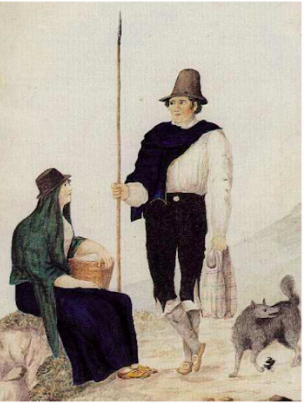Indigenous costumes of Saraguro, Loja, Ecuador
 |
| 18th Century Spanish mountain peasant dress (WikiMedia) |
Traditional dress worn by the indigenous majority in the towns of San Lucas and Saraguro is both complex and intriguing. Living north of the city of Loja, but still in Loja Province, the residents of these locations are Kichua who purportedly came here to occupy the land after the Incan conquest.
The possible origins of their costumes is a surprise and also foreign. The controversial suggestion is that the ruler of another conquering force, the king of Spain, decided what his South American subjects would wear. The Spanish made pronouncements about the language to be spoken, the foods produced and consumed in the new world, and religious observations. No area of life was unaffected by these invaders, including clothing. Charles III of Spain wanted his indigenous subjects to adopt the costumes of European mountain peasants. Although there is no absolute proof of this assertion, there are similarities in style between the costumes of the early European mountain people and the current indigenous dress in Loja’s sierra towns.
 |
| Contemporary dress in Saraguro (La Hora) |
Handmade of mostly local materials, indigenous costumes in Loja province can cost thousands of dollars when fully assembled. They are a testament to the skill of Saraguro’s spinners, weavers, felters, embroiderers, and jewelers. Worn proudly each day, women will have an ankle length inner skirt topped by a black over skirt wrapped like a sarong and held in place by a colorfully back-strap woven or embroidered sash. The outfit includes a blouse, also colorfully embroidered, with a small black shawl topper held in place with a silver ‘Tupo’ or long spear-shaped fastener that resembles the fibula going back to Roman times in Europe. The tupo’s sunburst shape symbolizes the solidarity of the community together. Explanations for why black is the dominant color of the costume range from the practical idea that the dark shade warms the body at a high altitude to a fanciful legend that the Saraguro people are mourning the death of the their last Incan king and forebearer. Kichua women complete their ensemble with elegant hand-made jewelry made of silver filigree or lacy fine beadwork including large chandelier earrings and colorful beadwork "collares'' that reach from neck to shoulder.
 |
| Spectacular embroidery (Marco Guaillas) |
Men and women share the same taste in hats that protect from the harsh rays of the Sierran sun. Both sexes favor dark felt small-brimmed fedoras and Capotain ‘sugar-loaf’ hats, which have been in style here since the early Renaissance. For special occasions, both men and women wear Saraguro’s signature black and white spotted broad brimmed hats. The spotted hats are still manufactured by specialty milliners out of homegrown sheep’s wool. The days-long process produces a very stiff and heavy felt held together with albumen. The hats were not always decorated with black spots, but the style appeared to catch on sometime in the early-to-mid 20th century.
 |
| Alforjas (saddle bags) in use (Somos Saraguro) |
The Kichua men of Saraguro wear calf-length dark pants which can be topped with light colored homespun chaps for more dressy occasions. The pants may be held up with a simple leather belt or with a wider metal studded style that supports a decoratively sheathed machete. Pants can be accompanied by shirts that range from traditional woven sleeveless pullovers to button front long-sleeve European styles. The shirts can have jackets on top or homespun mantles or ponchos. Both men and women carry woven ‘alforja’ saddle bags of varying sizes. Men and women will also wear leather boots and lace-up shoes with their outfits or locally made cloth espadrilles.
 |
| Well outfitted man (Marco Guaillas) |
The accessories described above: jewelry, bags, shawls, sashes, belts, and soft shoes are all produced in abundance to sell to tourists and visitors in Saraguro’s craft co-op open seven days a week. To learn current open hours of the craft fair during the COVID-19 restrictions, and for guided tours of Saraguro, contact Life In Loja.
This blog post is an example of how the team at Life in Loja helps tourists and visitors, expats and immigrants, to better appreciate the many aspects of living in Loja, Ecuador. If you would like to know more about our custom tours and relocation services then contact us by email or phone/WhatsApp at 593-098-674-5994 to begin a conversation.


I saw a YT video por Nancy_Risol a while ago, where she talks about the traditional ways of dressing and the costs associated with it. Highly recommended, but must "warn" others that it's only in Spanish. She is wonderful, IMO!
ReplyDeleteI will definitely check it out!
Delete